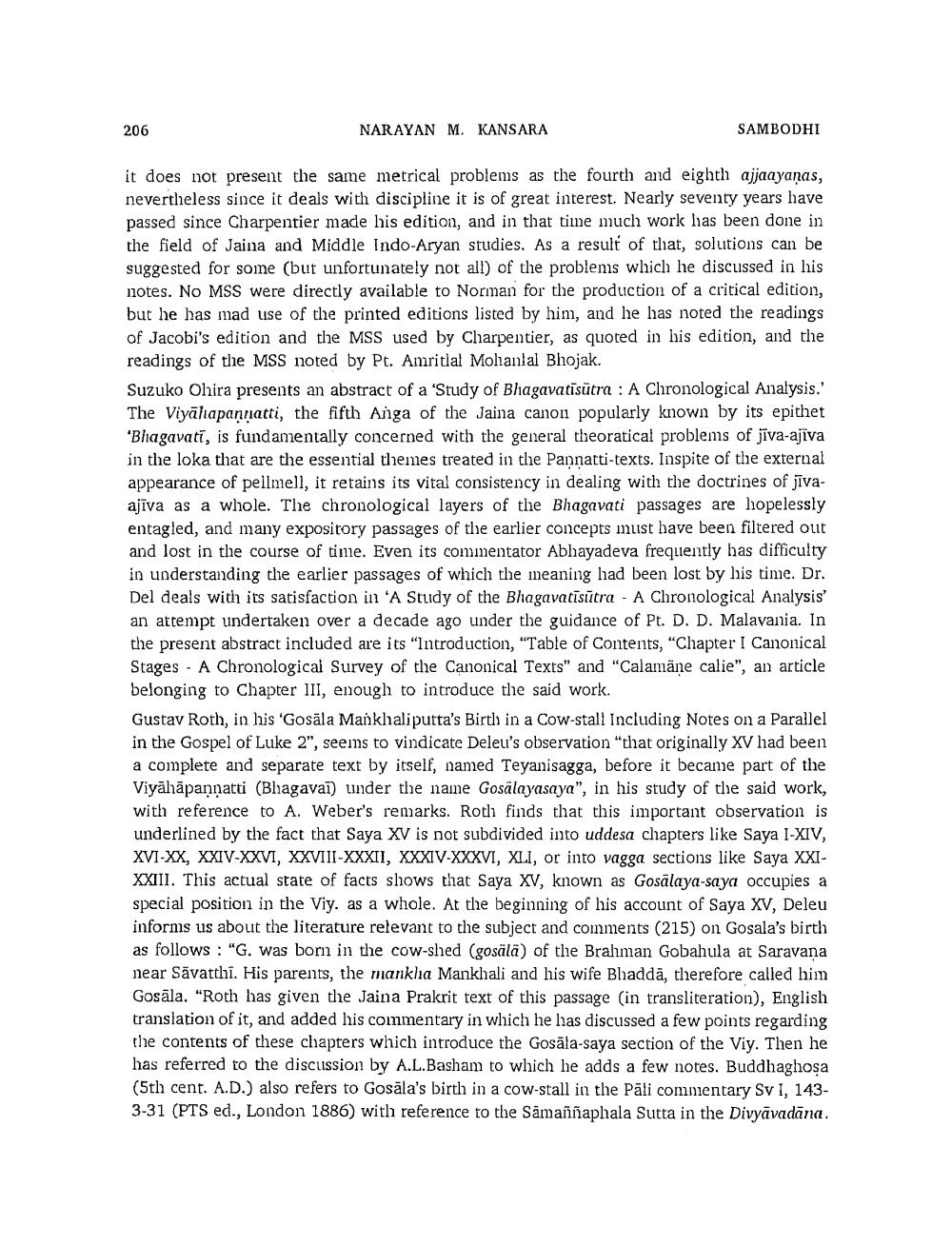________________
206
NARAYAN M. KANSARA
SAMBODHI
it does not present the same metrical problems as the fourth and eighth ajjaayanas, nevertheless since it deals with discipline it is of great interest. Nearly seventy years have passed since Charpentier made his edition, and in that time much work has been done in the field of Jaina and Middle Indo-Aryan studies. As a result of that, solutions can be suggested for some (but unfortunately not all) of the problems which he discussed in his notes. No MSS were directly available to Norman for the production of a critical edition, but he has mad use of the printed editions listed by him, and he has noted the readings of Jacobi's edition and the MSS used by Charpentier, as quoted in his edition, and the readings of the MSS noted by Pt. Amritlal Mohanlal Bhojak.
Suzuko Ohira presents an abstract of a 'Study of Bhagavatisūtra: A Chronological Analysis." The Viyahapannatti, the fifth Anga of the Jaina canon popularly known by its epithet "Bhagavati, is fundamentally concerned with the general theoratical problems of jiva-ajīva in the loka that are the essential themes treated in the Pannatti-texts. Inspite of the external appearance of pellmell, it retains its vital consistency in dealing with the doctrines of jivaajīva as a whole. The chronological layers of the Bhagavati passages are hopelessly entagled, and many expository passages of the earlier concepts must have been filtered out and lost in the course of time. Even its commentator Abhayadeva frequently has difficulty in understanding the earlier passages of which the meaning had been lost by his time. Dr. Del deals with its satisfaction in 'A Study of the Bhagavatisūtra - A Chronological Analysis" an attempt undertaken over a decade ago under the guidance of Pt. D. D. Malavania. In the present abstract included are its "Introduction, "Table of Contents, "Chapter I Canonical Stages A Chronological Survey of the Canonical Texts" and "Calamane calie", an article belonging to Chapter 111, enough to introduce the said work.
Gustav Roth, in his 'Gosala Mankhaliputta's Birth in a Cow-stall Including Notes on a Parallel in the Gospel of Luke 2", seems to vindicate Deleu's observation "that originally XV had been a complete and separate text by itself, named Teyanisagga, before it became part of the Viyāhāpaṇṇatti (Bhagavai) under the name Gosalayasaya", in his study of the said work, with reference to A. Weber's remarks. Roth finds that this important observation is underlined by the fact that Saya XV is not subdivided into uddesa chapters like Saya I-XIV, XVI-XX, XXIV-XXVI, XXVIII-XXXII, XXXIV-XXXVI, XLI, or into vagga sections like Saya XXIXXIII. This actual state of facts shows that Saya XV, known as Gosalaya-saya occupies a special position in the Viy. as a whole. At the beginning of his account of Saya XV, Deleu informs us about the literature relevant to the subject and comments (215) on Gosala's birth as follows: "G. was born in the cow-shed (gosälä) of the Brahman Gobahula at Saravana near Savatthi. His parents, the mankha Mankhali and his wife Bhadda, therefore called him Gosāla. "Roth has given the Jaina Prakrit text of this passage (in transliteration), English translation of it, and added his commentary in which he has discussed a few points regarding the contents of these chapters which introduce the Gosala-saya section of the Viy. Then he has referred to the discussion by A.L.Basham to which he adds a few notes. Buddhaghosa (5th cent. A.D.) also refers to Gosala's birth in a cow-stall in the Päli commentary Sv I, 1433-31 (PTS ed., London 1886) with reference to the Samaññaphala Sutta in the Divyavadana.




